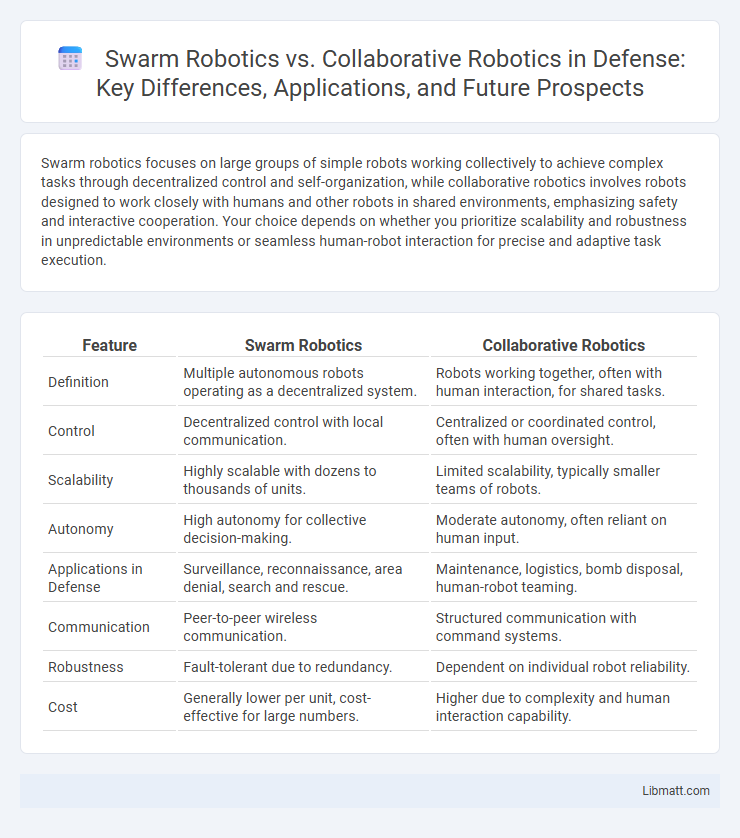Swarm robotics focuses on large groups of simple robots working collectively to achieve complex tasks through decentralized control and self-organization, while collaborative robotics involves robots designed to work closely with humans and other robots in shared environments, emphasizing safety and interactive cooperation. Your choice depends on whether you prioritize scalability and robustness in unpredictable environments or seamless human-robot interaction for precise and adaptive task execution.
Table of Comparison
| Feature | Swarm Robotics | Collaborative Robotics |
|---|---|---|
| Definition | Multiple autonomous robots operating as a decentralized system. | Robots working together, often with human interaction, for shared tasks. |
| Control | Decentralized control with local communication. | Centralized or coordinated control, often with human oversight. |
| Scalability | Highly scalable with dozens to thousands of units. | Limited scalability, typically smaller teams of robots. |
| Autonomy | High autonomy for collective decision-making. | Moderate autonomy, often reliant on human input. |
| Applications in Defense | Surveillance, reconnaissance, area denial, search and rescue. | Maintenance, logistics, bomb disposal, human-robot teaming. |
| Communication | Peer-to-peer wireless communication. | Structured communication with command systems. |
| Robustness | Fault-tolerant due to redundancy. | Dependent on individual robot reliability. |
| Cost | Generally lower per unit, cost-effective for large numbers. | Higher due to complexity and human interaction capability. |
Introduction to Swarm Robotics and Collaborative Robotics
Swarm robotics involves multiple robots working autonomously and in a decentralized manner to achieve complex tasks, inspired by biological swarms such as ants or bees. Collaborative robotics focuses on robots designed to interact closely with humans and other robots, emphasizing coordination and shared task execution. Understanding these distinctions helps you choose the right approach for scalable automation and human-robot interaction in various industries.
Defining Swarm Robotics: Key Concepts
Swarm robotics is defined by the coordination of large groups of simple, autonomous robots that collaborate through decentralized control and local communication to achieve complex tasks. Key concepts include self-organization, scalability, robustness, and emergent behavior, allowing swarms to adapt dynamically to changing environments without centralized oversight. This approach emphasizes distributed algorithms and cooperative interactions, distinct from collaborative robotics, which typically involves fewer robots with centralized control and explicit task-sharing protocols.
Understanding Collaborative Robotics: Core Principles
Collaborative robotics centers on human-robot interaction where robots work alongside human operators to enhance productivity and safety through shared tasks and real-time communication. Core principles include adaptability, safety features such as force sensing and collision avoidance, and intuitive programming interfaces that allow seamless cooperation. These robots are designed to complement human skills by performing repetitive or hazardous tasks, improving efficiency without replacing human oversight.
Technological Foundations of Swarm vs Collaborative Robots
Swarm robotics is based on decentralized algorithms inspired by natural systems such as ant colonies and bird flocks, emphasizing simple agents that operate collectively through local interactions without centralized control. Collaborative robotics relies on advanced sensor fusion, real-time communication, and precise motion planning to enable robots and humans or other robots to work safely and efficiently in shared environments. Your choice between the two depends on the task complexity and the need for flexibility versus coordinated, large-scale autonomous behavior.
Communication Models in Swarm and Collaborative Systems
Swarm robotics relies on decentralized communication models, where individual robots use local signals or environmental cues to coordinate actions and achieve collective behaviors without direct supervision. Collaborative robotics employs centralized or semi-centralized communication frameworks, enabling robots and human operators to exchange data and commands through networked systems for precise task execution. Understanding these communication differences helps optimize Your robotic system's efficiency and adaptability in dynamic environments.
Applications of Swarm Robotics in Industry
Swarm robotics finds applications in industries such as agriculture for crop monitoring and automated harvesting, logistics through warehouse inventory management, and environmental monitoring with distributed sensor networks. These systems leverage decentralized control and collective behavior to perform tasks efficiently across large areas or complex environments. Collaborative robotics, by contrast, emphasizes direct human-robot interaction for tasks like assembly, quality inspection, and material handling within manufacturing settings.
Real-world Uses of Collaborative Robotics
Collaborative robotics are widely used in manufacturing environments to enhance human-robot interaction, improving productivity and safety by working alongside human operators in assembly lines, quality control, and packaging tasks. These robots assist in logistics and warehousing, optimizing inventory management and order fulfillment through seamless cooperation with human workers. Unlike swarm robotics, collaborative robots are designed for close collaboration with humans, emphasizing precision and adaptability in structured industrial settings.
Comparative Analysis: Efficiency and Scalability
Swarm robotics excels in scalability by leveraging large numbers of simple, decentralized robots that cooperate to complete complex tasks efficiently, adapting dynamically to environmental changes. Collaborative robotics, designed for direct human-robot interaction, offers higher precision and task-specific efficiency but faces scalability challenges due to increased complexity and cost per unit. Your choice between swarm and collaborative robotics should consider the operational scale and required adaptability, balancing swarm robotics' mass deployment with collaborative robotics' specialized performance.
Future Trends in Swarm and Collaborative Robotics
Future trends in swarm robotics emphasize decentralized control systems, enabling large groups of autonomous robots to perform complex tasks through local interactions and collective intelligence. Collaborative robotics is advancing with enhanced human-robot interaction technologies, leveraging AI-driven adaptability and safety features to work seamlessly alongside humans in industrial and service environments. Integration of edge computing and 5G connectivity is expected to boost real-time data processing and coordination for both swarm and collaborative robotic systems, driving efficiency and scalability in various applications.
Choosing the Right Robotic Approach for Your Business
Swarm robotics excels in large-scale, decentralized tasks requiring numerous simple robots working in unison, ideal for expansive agricultural monitoring or environmental sensing. Collaborative robotics, or cobots, are designed for direct human interaction in shared workspaces, optimizing precision-driven manufacturing and assembly processes. Businesses should evaluate task complexity, workspace environment, and scalability needs to determine whether swarm robotics' distributed autonomy or collaborative robotics' human-robot synergy best enhances operational efficiency.
Swarm robotics vs Collaborative robotics Infographic

 libmatt.com
libmatt.com